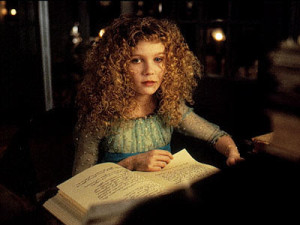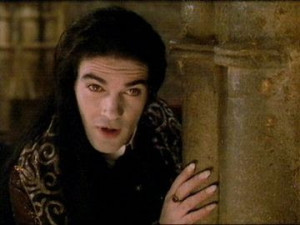There is something about vampires that just fascinates moviegoers. Maybe it’s their elusive nature, their pale-white complexion and superhuman strength, or maybe it’s their seductive promise of immortality for the simple exchange of one’s soul. And contrary to popular belief, vampires have been revered long before there was “Twilight.” American author Anne Rice has chronicled vampires in her many novels, but none so poignantly as her “Vampire Chronicles” anthology, the most popular volume being “Interview with the Vampire.” The movie adaptation, rightly, deals with vampirism, but goes deeper; making it a more human and forlorn take on the subject than some of its counterparts. With solid acting and character development, as well as striking set pieces, “Interview with the Vampire” is not only a great entry into the genre, but a thoroughly engrossing movie on any level.
The star of this movie is undoubtedly Louis de Pointe du Lac (Brad Pitt), who is one of the most depressing vampires you have ever seen. At the beginning of the story, he is shown leering over the balcony of a lofted apartment building. The setting is San Francisco, modern time. He has agreed to an interview with a shady journalist (Christian Slater) who has followed him because he “seemed interesting.” How interesting does he seem after Louis reveals himself to be a vampire? Very much so. So much so as to steer the journalist into mortal danger. But Louis is a good vampire, he assures him. “I wanted to suck your blood. But you needn’t worry about that now.”
The bulk of “Interview with the Vampire” is just that – an interview between the journalist and Louis as the latter relays his story. Beginning not with his birth, but his ‘birth to darkness’ as Louis puts it, the movie proceeds to paint his dark and melancholy story.

We learn quickly about Louis. He lost his wife and unborn son in childbirth, left to manage his large plantation by himself. Sinking in depression he attempts, through passivity, to end his life. However, he comes closer than he expects when he is attacked by the evil vampire Lestat, who offers him a choice: death, or immortality. The former seeming to pale to the latter, Louis takes him up on his offer and transforms into a vampire.
The movie works because it paints his ‘birth to darkness’ much like a real birth. Louis sees the world anew, living his days at night and his night during the days. At a breakneck pace, Louis attempts to grow accustomed to his new life – late nights, high-society parties, backdoor saloons – anywhere where a fresh ‘meal’ can be acquired. Lestat is an old hand at this, and shows Louis the ropes. However, Louis, in his inner-struggle, suffers one tragic paradox: he refused to kill humans, clinging to, as he calls it, “a lingering respect for human life.” Much to Lestat’s chagrin, he hunts rats and small animals. Living? “I wouldn’t call it living,” Lestat murmurs. “I’d call it surviving.”
However, things change when Louis, in a period of drought, preys on the abandoned 12-year-old daughter of a dying plague victim (Kirsten Dunst, “Spider-man”), and tastes human blood for the first time. It is here that we really see the pain his character (and possibly Anne Rice) feels for vampirism. He runs off, Lestat trailing after him, taunting, “How you love your precious guilt!” Louis simply cannot accept who he is, treating vampirism as more a curse than the romantic allure he initially felt drawn to. He retreats. However, he has left an indelible mark on the little girl – at the hands of Lestat, she too becomes a vampire.
 It is through the creation of Claudia that the movie intensifies. It’s mood swings along with its two fiercest characters – Lestat and Claudia – with Louis the unwilling mediator. It is here also that the movie shows its strongest asset – superb acting by all involved. Cruise pulls off the role of the wizened vampire brilliantly, adding a perfect amount of wit, sarcasm, and bloodlust. Cruise is really at the top of his game. When a tailor is clumsily making alterations to a dress for Claudia by candlelight and asks to reschedule during the day, Lestat’s response is comical and telling. “Madame, my days are sacrosanct.” However, more somber scenes, such as when he scolds Louis for fighting his burgeoning bloodlust are equally balanced, and show a much more complicated character than simply a one-sided, evil vampire.
It is through the creation of Claudia that the movie intensifies. It’s mood swings along with its two fiercest characters – Lestat and Claudia – with Louis the unwilling mediator. It is here also that the movie shows its strongest asset – superb acting by all involved. Cruise pulls off the role of the wizened vampire brilliantly, adding a perfect amount of wit, sarcasm, and bloodlust. Cruise is really at the top of his game. When a tailor is clumsily making alterations to a dress for Claudia by candlelight and asks to reschedule during the day, Lestat’s response is comical and telling. “Madame, my days are sacrosanct.” However, more somber scenes, such as when he scolds Louis for fighting his burgeoning bloodlust are equally balanced, and show a much more complicated character than simply a one-sided, evil vampire.
Likewise Dunst nails the part of the bratty new vampire child with ease. She’s torn between liking her new life and hating it. A bloodlust equal to Lestat’s, she initially becomes his favorite. However, her anger over never aging and remaining he and Louis’ ‘little girl’ forever escalates until she, on many occasions, resents both men completely. Her dynamic between the two men intensifies also when she learns that Lestat may have only turned her for a far more sinister reason than her company: to keep guilt-ridden Louis from abandoning Lestat and forging off on his own.
However, the strongest acting simply lies with Pitt. As the tortured vampire, he truly owns his character. His guilt humanizes him, making him question the nature of vampires to kill. Honestly, it’s no surprise. Pitt is another actor, like Matthew McConaughey, renowned for leading man roles and being Hollywood’s go-to ‘stud.’ However, he’s also an actor of unparalleled ability. Fans of last year’s off-beat “Tree of Life” will remember the overbearing and abusive father he portrayed in that film more as a living, breathing menace – and not that he was played by Brad Pitt.
 Aside from the acting, the movie also does a splendid job of rendering its visuals. “Interview” takes us through the centuries, from the 1700s to modern times. Set pieces, such as sweeping skylines and run-down warrens are well done, and the Elizabethan era costumes and sets are top of the line. Less care is put into modern day vistas like San Francisco, however. “Interview” focuses more on the genesis of these tortured characters, and less focus on where they end up.
Aside from the acting, the movie also does a splendid job of rendering its visuals. “Interview” takes us through the centuries, from the 1700s to modern times. Set pieces, such as sweeping skylines and run-down warrens are well done, and the Elizabethan era costumes and sets are top of the line. Less care is put into modern day vistas like San Francisco, however. “Interview” focuses more on the genesis of these tortured characters, and less focus on where they end up.
On par, “Interview with the Vampire” is a solid movie that will doubtless entertain. My only complaint is that it loses something along the way. The first and second acts, which understood the importance of character development crashes headfirst into its third act, as if it suddenly realized that it must have progression and plot. Too many new characters are introduced (such as the nonsensical legion of vampires led by the equally nonsensical Armand, played by Antonio Banderas). No time is given to develop them – they exist solely as a means to force an ending the movie never really needed. A simpler, less dramatic plot device could have done much more than the action-packed finale presents. The beginning and middle of the film is very close to a work of art – the third act, regrettably, is akin to watching this same masterpiece being slowly torn apart.
– by Mark Ziobro



1 Comment
I think your crazy. This movie is slow moving and has pacing problems.